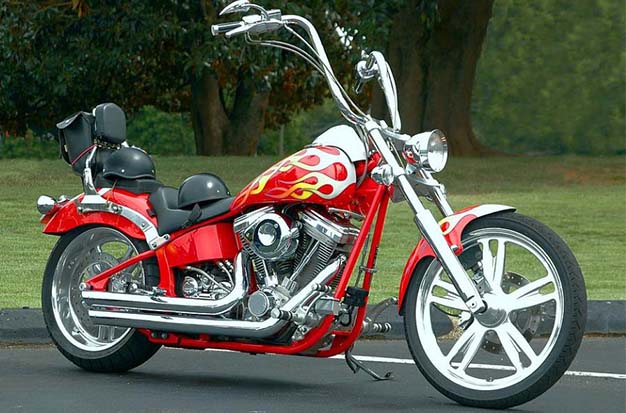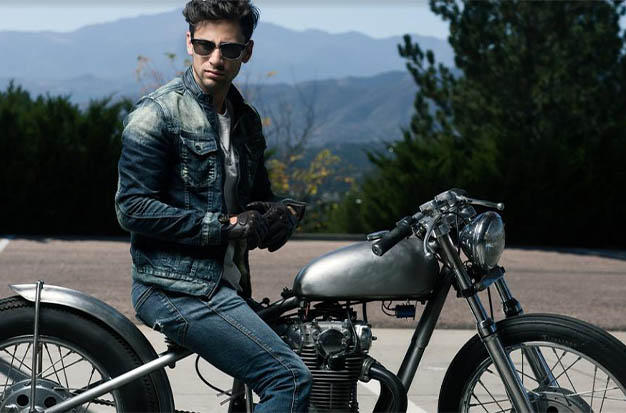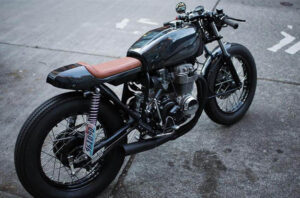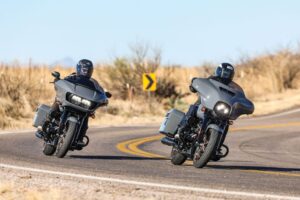Is it hard to ride a motorcycle? The first time you try to ride a motorcycle, it is only difficult. Riders find themselves quickly transitioning from practicing in a parking lot to free riding on open roads because our cognitive abilities and muscle memory quickly adapt to the new situation.
In this article, we go into great detail about how hard it is to learn to ride a motorcycle, as well as some topics that are connected to this question. My goal is to provide a thorough response that is beneficial on a number of levels.
What You Need To Learn For Riding a Motorcycle
Balancing A Motorcycle
A motorcycle can be balanced very similarly to a bicycle. The only real difference is that a motorcycle has a lot more weight, which might make it harder at higher speeds. A motorcycle may be simpler to balance on at slow speeds than a bicycle. If you have never ridden a bicycle, I advise you to learn how to do so first because riding a motorcycle requires the ability to balance on two wheels.
Understanding Countersteer
Motorcycles can steer left or right by turning the handlebar in the opposite direction of where you want to go, a maneuver known as countersteering. Although DanDanTheFireman has some excellent explanations on this subject, I advise against giving it too much thought because it might make you confused. If you can turn a bicycle, you already possess the necessary skill because countersteer is also used to make turns on bicycles.
Using A Clutch
In order to decouple the engine from the drive that rotates the wheel, the clutch must be engaged. The ability or instinct to engage and disengage the clutch at the appropriate times remains the same, despite the fact that motorcycle clutch levers are very different from a clutch pedal on a car. It can be much simpler to learn how to ride a motorcycle if you have experience driving a manual car.
Using a Turn-Throttle
Turn-throttles are only found on motorcycles and scooters, so for first-time riders, it might be an entirely new experience. However, the fundamental ability to use the clutch and the throttle at the appropriate moment is the same on a motorcycle as it is on a manual car.
Shifting Gears
The majority of motorcycles have a manual gearbox that can be controlled with the left foot, in contrast to vehicles with automatic transmissions. The rider must be able to control the clutch, throttle, and gears with their foot at the same time in order to be able to shift gears. Being able to drive a manual car can help a rider understand this, but the way in which the gears are changed is very different.
Using The Brakes
It will be a relief to first-time riders to learn that a motorcycle’s brakes are very similar to those on a bicycle. The rear brake is not on the left handlebar, which is the only distinction. A pedal in front of the right footpeg is used to control it instead. Similar to a bicycle, the front brake of a motorcycle is located on the right handlebar.
Knowing The Rules Of The Road
If you don’t have a license for any other type of vehicle, you may still need to learn the rules of the road in addition to learning how to control and balance a motorcycle. If you are already familiar with the road regulations, you will be able to concentrate more on the motorcycle’s controls and feel a little more at ease.
How Long It Takes To Learn To Ride a Motorcycle
It again depends on the skill set that you have acquired over the course of your life. You should be able to learn how to ride a motorcycle more quickly the more of these abilities you already possess.
These are the skills that will make learning to ride a motorcycle faster:
- Being able to ride a bicycle
- Being able to drive a manual car
- Knowing the rules of the road
Depending on the skills they already possess and the motorcycle they are using to learn, I believe it should take a new rider between 2 and 8 weeks of daily practice to learn how to ride a motorcycle safely. However, the time required will vary depending on the individual and the skills they already possess.

How To Ride A Motorcycle For Beginners: Take These 6 Easy Steps
Step 1: Gear Up
First things first: there is some risk associated with riding a motorcycle. It’s up to you to reduce that risk as much as you can. To accomplish that, you’ll need the right motorcycle equipment to keep you safe in the event of a collision.
Get ready, even if it’s your first lesson. Put on a helmet, gloves, sturdy boots that reach your ankles, and a motorcycle jacket and pants. If you’re unsure of the type of riding you’ll be doing the most once you get your license — on the road, off the road, adventure, street, enduro — stick to the fundamentals. For starters, armored motorcycle clothing or Kevlar or Dyneema – reinforced motorcycle jeans and jackets, abrasion-resistant fabrics, will do.
Step 2: Choose Your Motorcycle
When learning to ride, which bike should you aim for? At this point, it doesn’t really matter what brand or model the car is. The weight to power ratio is what you ought to focus on. When learning to ride a motorcycle for the first time, a beginner needs a lightweight, manageable vehicle. Then, as you advance, you can switch to larger, heavier, and more powerful motorcycles. Pick something between 250 and 650 cc that is low and lightweight for the time being.
There is no such thing as a motorcycle for beginners; any bike can serve as your first bike. However, if you can, try just sitting down on a motorcycle you like, feel how it feels, and contrast it with a few other vehicles. Check to see if you can put both feet down without discomfort when you swing a leg over that saddle. Feels the bike is balanced to you? Is it simple to get on, get off, and set it down on a side stand? Do you like where you’re sitting right now?
Try moving the motorcycle back and forth in addition to sitting on it to determine whether you are comfortable. Wheel it around a little after placing it on the stand and the center stand. Both in and out of the saddle, you should be able to control the bike with ease.
This will make learning the fundamentals of motorcycle riding much faster and more natural. Always keep in mind that balance is more important than muscle. A lighter motorcycle will make learning the fundamentals much simpler. You can always start looking for more powerful and larger machines once you’re a more experienced and secure rider.
Step 3: Learn To Brake
It’s time to start your motorcycle moving since you are now seated inside of it. However, learning to brake is a prerequisite to moving. Your front brake lever is on your right handlebar, and your rear brake pedal is located on your right side. Use both brakes equally to slow down or stop, and always make sure you’re stepping on the rear brake and pulling in the front brake lever gently and gradually. Never grab or stomp on your brakes, as this could cause the wheels to lock up and throw you off balance.
To learn to brake in a controlled, smooth motion as opposed to jerking the bike to a stop, lightly tap the rear brake pedal and slowly pull in the front brake lever. While the bike is still, practice applying the brakes. Roll a little forward and then tap the rear brake to get a feel for it. Try to find the sweet spot where the brakes engage without abruptly grabbing the wheel discs by repeating this with your front brake.
Step 4: Clutch And Throttle
It’s time to start your bike and get familiar with the controls now that you are comfortable with stopping. Most new riders find shifting their gears to be their biggest source of fear, but it’s actually much simpler to learn than you might think. On a motorcycle, the first gear is down, followed by neutral, second, third, fourth, and fifth, which you shift up into.
You must pull the clutch lever in to engage the gears. Pull the clutch lever in to engage the first gear, then gently roll the throttle while releasing the clutch at the same time (just like in a car!) to get going.). Gently release the clutch as you gradually increase the amount of throttle once the bike has begun to move. When you reach higher RPMs, fully engage second gear, let off the gas, and pull the clutch lever in. Once you are in first gear and ready to slow down, shift down until you reach neutral. Continue doing it until it comes naturally!
Step 5: Turning
The biggest lesson in learning to ride a motorcycle is to master the controls. The most crucial skill to master is turning. Once you’ve gotten a feel for it, though, you can begin learning the remaining fundamentals. What about corners, U-turns, and pirouettes in a parking lot? Riding a bicycle in a straight line is one thing, but what about those maneuvers?
Do not rely solely on turning your handlebars to keep the bike steady and stable when cornering. You must lean with the bike as it leans into a corner. Go with the flow rather than trying to stop your bike. Always keep your throttle steady and keep your eyes forward as you drive; if you keep your gaze fixed on your front tire, you run the risk of stalling or crashing. You can maintain balance and steer the bike in the desired direction by looking through the corner.
Step 6: Practice Makes Perfect
It’s time to start driving now that you’ve finished an MSF course and obtained your license. You should practice as much as you can as a new rider but go slowly. Before you use highways and interstates, practice riding on quiet, two-lane roads and safely navigating traffic. As you ride more, you will become more familiar with your bike, the controls will become second nature, and you will grow more at ease on all types of roads and in all types of traffic. The key is to start out slowly, hone your skills, and take in as much of the ride as you can. If you get yourself into stressful situations on a busy street or on a fast freeway, you might lose interest in riding a motorcycle.
Conclusion
So there you have it: use these easy instructions and advice to learn how to ride a motorcycle, practice as frequently as you can, and remember to enjoy yourself while doing it. We wish you many happy miles on two wheels because riding a motorcycle is all about freedom and enjoying the ride.



